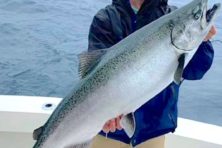WILD THINGS: Lake Trout Plan a Good Start, but ‘Too Many’ Are Already Out There
- Share
- Tweet
- Pin
- Share

Sport anglers who lost the opportunity to harvest more lake trout this spring can’t get that back, but it should be a “go” from here on out.
During its meeting next week, the state Natural Resources Board (NRB) is expected to approve a Department of Natural Resources (DNR) recommendation to adopt an emergency order returning the Lake Michigan lake-trout bag limit to five, with a continuous harvest season.
Tom Kleiman, owner of Accurate Marine, Tackle & Storage in Kewaunee, as well as president of the Wisconsin Lakeshore Business Association, is thankful that during recent years, the state has been giving anglers more of what they want: salmon, steelhead, brown trout and brook trout.
Kleiman said many fishers have long complained that the U.S. Fish and Wildlife Service’s push to restore native lake-trout populations has come at a cost to the more desired species, such as chinook and coho salmon, and rainbow and brown trout.
“Lake trout are a nice fish to fall back on, but most anglers want to see a shift away from the fed’s ridiculously high stocking numbers of lakers,” Kleiman said. “Many people feel they’ve been irresponsibly stocked, and an unchecked lake-trout population that is reproducing on its own can really do a number on baitfish.”
The rule, which is expected to be approved June 23, would extend the recreational-harvest rules that have been in place since 2017 but were inadvertently left to expire during the COVID-19 slowdown of state operations. That meant the daily bag limit reverted back to two.
Data collected since 2017 indicate that lake-trout harvest remained comfortably under recreational-harvest limits while the five-fish and year-round fishing regulations were in place.
DNR harvest estimates show that sport anglers haven’t hit the “safe harvest limit” of 82,000 lake trout since 1998, and in fact, they have averaged an annual catch of only 20,000 to 40,000 every year since 1999.
Not only would allowing anglers to harvest more lake trout not threaten federal trout-recovery goals for the native species, but the DNR – in a “green sheet” explaining the rule to NRB members – said that continuing expanded lake-trout harvests would help balance lake-trout impacts on the alewife prey base, which highly desirable salmon and steelhead also consume.
Despite decades of harvests far below quota (due to lake trout not being targeted as frequently as the more desired species), the DNR and NRB have established benchmarks to set a revised limit the following year of two lake trout per day if 90% of the “safe” quota is reached and a three-fish bag if 75% of the quota is reached.
That would seem to fly in the face of decades of underharvest and the DNR’s own data, which show natural reproduction trending upward and a number of metrics – including “10 [lake trout] age groups over age seven” – above target.
Sportfishing Outlook
There’s been some very good salmon and trout fishing along the Door and Kewaunee county lakeshore, mainly three to six miles out off most ports.
Green Bay action has been good for walleyes on the lower bay and for smallmouth bass, pike and perch everywhere else, with an occasional walleye, trout or even salmon hooked.
Bluegills, rock bass, sunfish, perch, crappies, bass and pike are hitting in bays and harbors, as well as inland lakes. Decent shore opportunities can be had at a number of county and state parks, as well as at city and village docks.
Smallmouth-bass fishing has been catch-and-release-only in the Ahnapee and Kewaunee rivers, the Mink River and all other Lake Michigan tributaries north of Highway 29. That will change Saturday, June 19. Smallmouths also can’t be kept until July 1 in all waters within one-quarter mile of all islands in the Town of Washington Island.
Yellow-perch fishing had been closed on Lake Michigan and tributaries such as the Ahnapee River, but it reopened June 16. Green Bay perch fishing reopened May 20.
36th Annual Kids’ Fishing Derby
Along with the other special plans you may have in mind for this Sunday – Father’s Day – consider including fishing. The 36th annual Kids’ Fishing Derby will take place June 20, 11 am – 2 pm, at Little Lake in Sturgeon Bay. All kids will receive prizes, a hot dog, soda and chips, and trophies will be awarded for the biggest fish.
Go Wild Recognized
The DNR’s Go Wild license and registration system has been recognized in two international award competitions.
Go Wild was launched five years ago to provide anglers, boaters, hunters and recreational-vehicle users with an easy-to-use, online option to manage their license and registration purchases. Last year, the system processed more than 1.8 million transactions.
More than 6,000 entries from across the U.S. and around the world were received for both the Communicator Awards, overseen by the Academy of Interactive and Visual Arts; and the Hermes Awards, administered by the Association of Marketing and Communication Professionals. Only about one of every five entries earns the awards.
Water-Levels Update
As of June 11, Lake Michigan was still 14 inches above its 100-year monthly average, but it was down 20 inches since the June 2020 record high.



